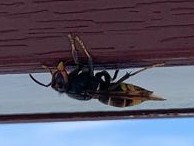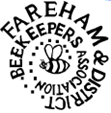01-10-25 – SIGHTING ON PORTSMOUTH FERRY
A Yellow Legged Asian Hornet was spotted on the Portsmouth to Santander ferry by a Hampshire Beekeeper. It is not known if it was originally on the ship or had come from England. Extra vigilance in the Portsmouth Port Area is required in case it hitched a lift from there. It has been reported to the NBU as a precaution. Thank you to Linda Milne who shared this information.

25-09-25 – SECONDARY NEST IN SOUTHAMPTON DOCKS AREA
Following coordinated monitoring in the Southampton Docks area over the last month, a YLAH secondary nest was found in Freemantle Lake Park. This is scheduled for destruction and sent to Defra for analysis.
The nest was located using the new technology available to the NBU and took less than 4 hours to track and trace. It will be some time before we learn from Defra whether the nest was second-generation, but in all likelihood, this was the result of a hitchhiking queen on one of the ferries from France.
Well done to the team of beekeepers, the NBU Inspectors, and the AHAT team for their help and diligence that resulted in a successful nest location and destruction.
Mark Cooper
HBA AHAT Coordinator
13-05-25 – DEFRA UPDATE
A credible sighting in the New Milton area.
25-04-25 – DEFRA UPDATE
The Animal and Plant Health Agency’s National Bee Unit (NBU) report that they have received two further credible reports of YLH’s in the Southampton area, including the first hornet caught in an NBU-placed trap.
On 17th April a householder in Hythe submitted a credible report of a YLH trying to build a nest in a playhouse in the garden. The householder was able to capture, confirm the species and kill it. However, it has not been possible to make contact with the reporter to verify or obtain the specimen as yet. This is approx. 4.5km from the Marchwood sighting 2 weeks ago and from the Marchwood nest in 2023.
On 23rd April, a local bee inspector found a YLH in an NBU-placed trap approx. 200m from the previous reported sighting in Marchwood.
09-04-25 – ASIAN HORNET FOUND IN MARCHWOOD

On Tuesday 8th April the NBU received a report of a YLH found in Marchwood, Hampshire. The hornet (which was alive, but dozy) was found by a householder when they removed the cover from a collapsible washing line.
The NBU responded to the report on the same day and a bee inspector collected the hornet which was sent to Fera Science.
The location is close to where 2 YLH nests were found in 2023. The local bee inspector set up queen monitoring traps on 9th April. The local Yellow-Legged Asian Hornet Team has been contacted and asked to responsibly monitor in the area.
SEPTEMBER 2024 – ASIAN HORNET NEST FOUND IN SOUTHAMTON COMMON
A member of the public’s credible report of a suspicious insect on the Asian Hornet Watch App near the Old Cemetery in Southampton had galvanised the NBU into track-and-trace operations to find the nest. It was located 17m high in an ancient ivy-clad tree, surrounded by undergrowth, deep in the Old Cemetery. Criss-crossed by public footpaths between close-packed graves and tombstones, the cemetery remains popular with walkers, dog owners and runners.


Image of the tree / Close up of the nest
Respect for the long-buried dead plus the dense vegetation ruled out use of a cherry picker. Tree climbers were the only way to deliver the insecticide and remove the nest although their ascent was delayed until the torrential rain stopped and conditions were less hazardous.
The following day conditions were safer for Dan Etheridge, the Central Regional Bee Inspector, together with James and Tom of Worthy Tree Care Ltd, to swing into action. They are highly experienced, hardened veterans of the 2023 Asian Hornet campaign amidst the dangerously difficult terrain of Capel-le-Ferne in Kent. Nevertheless, the cemetery tree was a worthy opponent, reluctant to give up its prize. Several hours of hacking, chain sawing and hand cutting were needed to create a passage up the tree. Meanwhile I kept watch to ensure that no members of the public wandered into potential danger.

Having cut partway up the tree, James reached a safe position with a clear view of the nest. The Wasp Pole Pro lance, with its 12-metre extension, enabled him to deliver two doses of Permethrin 0.5% broad spectrum insecticide: a camera attached to the tip enabled Dan on the ground to see what was happening inside the nest. There was no dramatic reaction from the nest inhabitants, but dead and dying hornets were soon littering the ground which Tom collected and put into specimen bottles.


James the tree climber with the lance / Dead or dying hornets on the ground
While the climbers and the ground crew had a well-deserved break, returning foragers soon succumbed to the treatment and joined their fellow hornets on the ground. It took more time and more hacking for James to cut the remaining passage and to reach the nest. Having sawed through the branch to which the nest was anchored, he bagged it securely and lowered it to the ground.

A further precautionary insecticide spray was required put an end to a few remaining live hornets before the bag could be opened safely and the nest taken out for photographic evidence.

Yet the day still wasn’t over. While packing to leave, the Asian Hornet Watch App delivered a report of another Asian Hornet caught by a nearby beekeeper in his kitchen. His hand-delivered specimen joined the nest on its journey to the Fera Laboratory for analysis. Fingers crossed that it came from the same nest.
Finally, carefully labelled monitoring traps were placed in the cemetery to catch any of the nest’s stragglers and monitor for other colonies. Local beekeepers have also been asked to increase vigilance and put out bait or monitoring stations.
The media interest in the incident has meant we could plug the Asian Hornet Watch App, emphasise the hornet’s actual features and dispel a few myths, while reminding the public to keep their eyes peeled as the Asian Hornet is more than just a beekeeper’s problem!
The speedy response plus the NBU team’s calm, competent professionalism was very impressive. It was reassuring to see the APHA/NBU/Hampshire Asian Hornet Contingency Plans working so smoothly.
Alan Baxter
AH Coordinator
Hampshire Beekeepers Association
